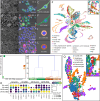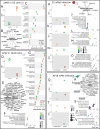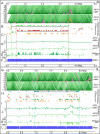This is a preprint.
Wolbachia induces host cell identity changes and determines symbiotic fate in Drosophila
- PMID: 40501974
- PMCID: PMC12157682
- DOI: 10.1101/2025.06.05.658111
Wolbachia induces host cell identity changes and determines symbiotic fate in Drosophila
Abstract
Many host-associated bacteria influence the differentiation of their eukaryotic host cells. The association between Wolbachia pipientis and Drosophila melanogaster offers a model for understanding how host-microbe gene expression co-evolves. Using Wolbachia-infected Drosophila cell lines, we show that the wMel strain alters host cell states, inducing novel gene expression programs that diverge from known cell types. Transcriptomic co-expression network analysis identified gene expression modules specific to each cell type and infection state, and revealed that wMel tailors its gene expression to host context. In macrophage-like host cells, wMel expresses pathogenic effectors, whereas in neuron-like cells, wMel upregulates metabolic genes. Micro-C chromatin contact data revealed that many of these infection-induced changes are epigenetically encoded, with wMel infection conferring reduced chromatin contacts and widespread transcriptional derepression in D. melanogaster. These findings show that the nature of Wolbachia symbiosis-mutualistic or pathogenic-emerges from host cell environments and suggest new paths for engineering host-specific microbial phenotypes.
Conflict of interest statement
Declaration of Interests: Richard E Green holds patents for the methods behind the Micro-C chromatin conformation capture kit and he holds a financial stake in the company who sells these kits, Dovetail Genomics. No other authors have any financial interests or patents to declare. None of the authors were board or advisory committee members or paid consultants related to this study or journal.
Figures





References
-
- Starr D.J., and Cline T.W. (2002). A host–parasite interaction rescues Drosophila oogenesis defects. Nature 418, 76. - PubMed
Publication types
Associated data
Grants and funding
LinkOut - more resources
Full Text Sources
